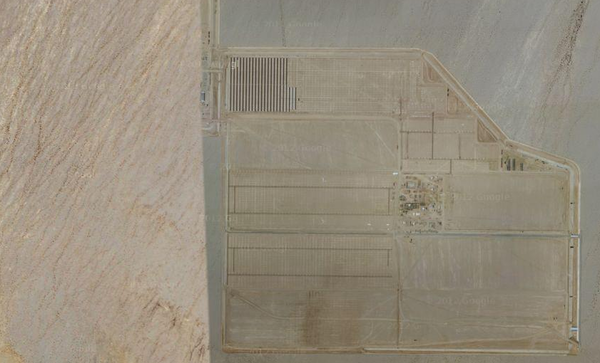'Massive' Flood Damage at Genesis Solar Project

The Genesis Solar Project construction site, pre-flood | Image courtesy Google Maps
According to representatives from the California Energy Commission (CEC) and the Bureau of Land Management (BLM), a storm system that moved through the California Desert on July 31 did massive amounts of damage to NextEra's Genesis Solar Project near Ford Dry Lake in Riverside County.
The flooding, apparently caused by blockage in a flood control diversion ditch, washed away as much as five feet of soil in some areas and uprooted support structures for the project's parabolic trough mirrors. The CEC reports that high winds accompanying the storm broke some already-installed mirrors.
As we publish this CEC staff are on the Genesis site assessing the damage, and NextEra and BLM are holding a meeting to determine both the extent of the damage and the future of the project.
According to the CEC, the flooding likely occurred because contractors had built a dirt bridge across a flood control channel in order to move heavy equipment across the channel. The bridge did include drainage pipes to carry moderate flows of water, but those pipes were apparently completely overwhelmed by the flood. The CEC further reports that the broken mirrors were not in the "stow" position that would have protected them against wind damage,
"At the present time, the Commission does not have any information indicating that the incident will have an impact on the construction schedule," a CEC representative told ReWire. The Commission hopes to have more information on the damage by mid-week.
The Genesis Solar Project is being built on 1,950 acres of BLM lands north of Ford Dry Lake, and if completed will generate 250 megawatts of power using parabolic trough solar thermal technology. The site, 25 miles west of Blythe, is hemmed in to the north by the Palen and McCoy mountain ranges.
The Genesis site has had its share of problems since construction began. Dust control has been an issue, with large clouds billowing off the site and impeding visibility on Interstate 10 when winds blow from the north. The site made national news headlines last winter when it was discovered that nearby desert kit foxes had contracted distemper -- the first known outbreak of the deadly disease among desert kit foxes.
ReWire will follow developments and provide updates as we find out more.
ReWire is dedicated to covering renewable energy in California. Keep in touch by liking us on Facebook, and help shape our editorial direction by taking this quick survey here.


